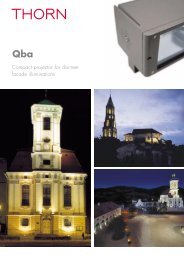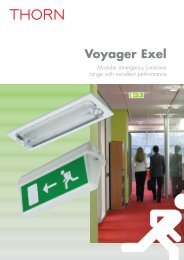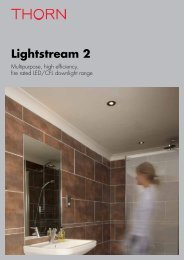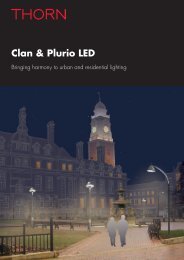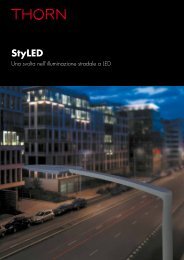Champion - THORN Lighting
Champion - THORN Lighting
Champion - THORN Lighting
You also want an ePaper? Increase the reach of your titles
YUMPU automatically turns print PDFs into web optimized ePapers that Google loves.
The role of the sports lighting<br />
designer is to find the right<br />
balance in meeting the needs<br />
of participants, astronomers<br />
and the local community.<br />
15<br />
<strong>Champion</strong> for lighting designers<br />
The skill of the lighting designer<br />
is to find the right balance<br />
in meeting the needs of the<br />
various stakeholders of<br />
sports installations.<br />
How can the lighting designer<br />
provide sufficient ‘on-pitch’<br />
performance (illuminance and<br />
uniformity),with a minimum of<br />
floodlights and minimise ‘offpitch’<br />
obtrusive light (sky glow<br />
and light spill)?<br />
Traditionally, at least one of these<br />
elements has had to suffer.<br />
‘Classic’ style projectors with<br />
excellent light output properties<br />
can provide excellent on-pitch<br />
performance with a minimum<br />
of floodlights, but they lack the<br />
optical control to minimise<br />
contributions to sky-glow and spill<br />
light. Conversely, ‘flat glass’<br />
floodlights can minimise obtrusive<br />
light, but have lower light<br />
outputs, thus increasing the<br />
number of floodlights required to<br />
light the installation.<br />
Optical performance of ‘flat<br />
glass’ foodlights and<br />
‘classic’ style projectors<br />
When analysing the geometry of<br />
sports lighting installations such<br />
as football, hockey or rugby<br />
pitches, we can see that some<br />
floodlights will need to be aimed<br />
at more than 60° from the<br />
perpendicular, if sufficient<br />
illuminance is to be achieved in<br />
the centre of the playing area.<br />
If the front glass is to be<br />
positioned parallel to the ground<br />
(flat), then the peak intensity<br />
angle of the floodlight needs to<br />
be somewhere between 60 - 70°<br />
from the perpendicular.<br />
When light passes through glass,<br />
some light is reflected back<br />
producing internal reflections<br />
which result, effectively, in lost<br />
light. If light passes through glass<br />
at 0°, then these internal<br />
reflections are minimised and<br />
approximately 90% of light is<br />
transmitted. As the angle<br />
increases, so do the internal<br />
reflections and, thereby, light<br />
losses. At an angle of 70°, less<br />
than 70% of light is transmitted.<br />
‘Flat glass’ floodlights will, at<br />
best, produce 20% less light than<br />
a ‘Classic’ style projector (which<br />
transmits light at an angle nearer<br />
to 0°) with the result that<br />
installations using ‘flat glass’<br />
floodlights will require 20 – 30%<br />
more fittings.<br />
The <strong>Champion</strong> solution<br />
The optical design of <strong>Champion</strong><br />
is unique and sets new standards<br />
for providing ‘on-pitch’<br />
performance whilst minimising<br />
the number of floodlights<br />
required and the contributions to<br />
obtrusive light.<br />
The reflector design of <strong>Champion</strong><br />
is modelled on those of ‘classic’<br />
style projectors. It is also highly<br />
efficient and designed to focus as<br />
much of the light produced by<br />
the lamp in the direction in which<br />
it is required.<br />
Furthermore, because the front<br />
glass is inclined within the body,<br />
the light passes through the glass<br />
at an angle that does not<br />
generate significant internal<br />
reflections and light losses.<br />
<strong>Champion</strong> generates light output<br />
ratios, and thereby on-pitch<br />
performances, normally<br />
associated with classic<br />
projectors.<br />
The body of <strong>Champion</strong> has been<br />
designed to act as a cowl<br />
providing the ‘light beam cut off’<br />
at 80° from the perpendicular<br />
that is required to minimise light<br />
spill. The cowl creates a ‘virtual‘<br />
light emitting surface, which is<br />
to be aimed parallel (flat) to<br />
the ground.<br />
<strong>Champion</strong> provides all the<br />
optical control elements<br />
associated with ‘flat glass’<br />
floodlights.<br />
Finally, the adjustable lamp<br />
feature provides a variety of<br />
optical distributions, from a<br />
single installed position, which<br />
can be mixed to achieve the<br />
required levels of uniformity.<br />
Examples of this can be seen<br />
in the template schemes<br />
section of this brochure.<br />
<strong>Champion</strong> provides excellent<br />
uniformity without the need<br />
to either tilt the floodlight,<br />
raise the mounting height or<br />
add extra floodlights to the<br />
scheme.<br />
Additional accessories for<br />
increased control of<br />
obtrusive light<br />
Adjustable ‘vertical light<br />
shields’ are particularly<br />
inventive accessories which<br />
have been developed for<br />
areas of extreme sensitivity to<br />
light spill. They are adjustable<br />
on site and enable the light<br />
beams to be ‘cut off’ at<br />
angles below 80° from the<br />
perpendicular.<br />
The front shield cuts the light<br />
beam to the front (usually<br />
the most critical direction) and<br />
both sides of the fitting. There<br />
is another accessory for<br />
cutting the light beam to<br />
the rear.<br />
The optical design of<br />
<strong>Champion</strong> combines output<br />
efficiency normally associated<br />
with standard floodlighting<br />
projects with the control of<br />
obtrusive light associated<br />
with ‘flat glass’<br />
asymmetric floodlights.


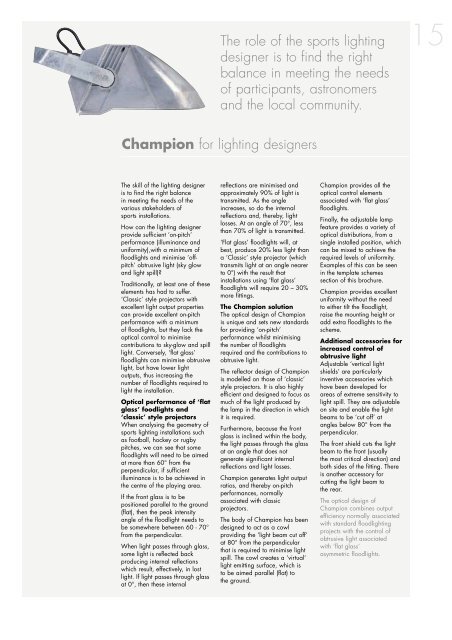
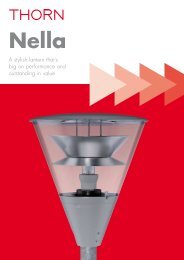
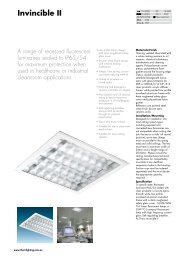
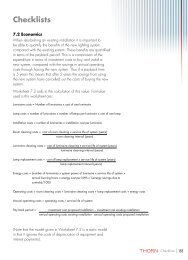
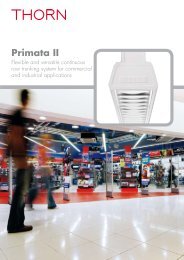
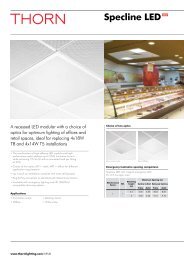

![Produkt brochure [PDF/4MB] - THORN Lighting](https://img.yumpu.com/50705283/1/184x260/produkt-brochure-pdf-4mb-thorn-lighting.jpg?quality=85)
